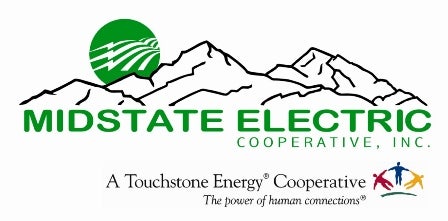What is a red flag warning?
Red flag warnings are issued by the National Weather Service when strong gusty winds are combined with high temperatures and low humidity.
What is a Public Safety Power Shutoff (PSPS)?
A Public Safety Power Shutoff (PSPS) is a preventative operation that utilities can use to help ensure their equipment does not start or contribute to wildfires during red flag conditions.
Does a red flag warning mean an automatic PSPS?
No. For example, in September 2020, a state-wide red flag warning was issued prompting Governor Brown to request that utilities enact a PSPS. Rather than opting for a PSPS, which would have shut power off to the entire service territory, MEC – along with many other utilities – opted to place our system on a high sensitivity setting.
The challenge with implementing a PSPS system-wide is that all lines would have to be patrolled before power could be restored. This could take weeks. By setting the system on a high sensitivity setting, only those lines that lose power have to be patrolled. The other benefit to setting the system on high sensitivity versus PSPS is fire districts, businesses and homes still have access to water to defend properties. The Oregon PUC has acknowledged that using high sensitivity settings is an appropriate tool to use in lieu of a PSPS.
During red flag conditions, MEC’s management staff will evaluate the conditions and take actions that are deemed appropriate. Our electrical system is well-maintained and our right of ways are in the best shape we have seen in years. Therefore, in most cases, placing our system on a high sensitivity setting will be our first line of defense. Only under imminent danger to life or property will MEC implement a PSPS. Examples of this would be if a fire has started and fire-fighting crews need the power shut off for their safety or if lines are on the ground that are energized.
What does placing the electric system on a high sensitivity setting do?
Placing the system on a high sensitivity setting is the process of placing a recloser – an automatic high-voltage switch that operates like a breaker – on non-reclose mode so the breaker will trip off and the line will be de-energized when an object comes in contact with a powerline.
High sensitivity settings can cause more short outages. Line crews must patrol the lines once the breaker trips, and power is brought back up in sections. This procedure is inconvenient at times, but it is the safest option we have for the protection of our employees and communities.
What if BPA issues a PSPS?
Bonneville Power Administration (BPA) is the agency from which MEC purchases wholesale power. BPA will notify their customers that they will enact a PSPS when they believe it is appropriate. Advance warning will be given – if possible – to MEC and therefore, you – our members – if this occurs. Unfortunately, if BPA implements a PSPS, we have no other options. We will be without power. We are hopeful this will be an extremely rare occurrence.
What is MEC doing to reduce wildfire risk?
MEC continues an aggressive vegetation management program. This includes tree trimming and brush clearing to reduce flammable material and mitigate fire risk around powerlines. Central Oregon will be particularly vulnerable to drought conditions and wildfire safety will be even more critical to our rural communities.
In addition to vegetation management, MEC invests in system hardening by building infrastructure that can withstand fire. This is done utilizing measures such as selective wood pole replacement with alternative materials in fire hazard areas as well as strategically converting overhead lines to underground.
How can you Prepare?
Check the Oregon Wildfire Map to keep informed about wildfires in and around Central Oregon: Oregon Wildfire Map - Current Oregon Wildfires, Forest Fires, and Lightning Strikes | Fire, Weather & Avalanche Center (fireweatheravalanche.org)
- Update your contact information with MEC by contacting member services at 541-536-2126 option 3.
- Have a personal safety plan in place for every member of your household (including pets).
- Plan for any medical needs like medications that need to be refrigerated or devices that require power. If someone in your household uses a medical device that requires power, please contact our office to inquire about placing a medical alert on your account so you will be notified in the event of a preplanned outage.
- Create or restock your emergency supply kit, including food, water, flashlights, a radio, fresh batteries, first aid supplies, and cash. For more information on how to build a kit, visit https://www.ready.gov/kit
- Identify backup charging methods for phones and medical equipment.
- Know how to open your garage door manually.
- Ensure any backup generators are ready to operate safely.
- Identify the unique needs of your family and loved ones in the area for your emergency plan.
- Designate an emergency meeting location.
Sign up for emergency alerts in your area:
- Deschutes County: https://www.deschutescounty.gov/.../sign-deschutes-alerts
- Klamath County: https://www.klamathcounty.org/300/Emergency-Management
- Lake County: https://www.lakecountyor.org/sign_up_for_or-alerts/index.php
